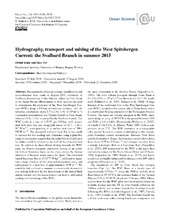| dc.contributor.author | Kolås, Eivind | |
| dc.contributor.author | Fer, Ilker | |
| dc.date.accessioned | 2019-05-27T11:01:52Z | |
| dc.date.available | 2019-05-27T11:01:52Z | |
| dc.date.issued | 2018-12-21 | |
| dc.Published | Kolås E, Fer I. Hydrography, transport and mixing of the West Spitsbergen Current: the Svalbard Branch in summer 2015. Ocean Science. 2018;14:1603-1618 | eng |
| dc.identifier.issn | 1812-0792 | en_US |
| dc.identifier.issn | 1812-0784 | en_US |
| dc.identifier.uri | https://hdl.handle.net/1956/19719 | |
| dc.description.abstract | Measurements of ocean currents, stratification and microstructure were made in August 2015, northwest of Svalbard, downstream of the Atlantic inflow in Fram Strait in the Arctic Ocean. Observations in three sections are used to characterize the evolution of the West Spitsbergen Current (WSC) along a 170 km downstream distance. Two alternative calculations imply 1.5 to 2 Sv (1 Sv = 106 m3 s−1) is routed to recirculation and Yermak branch in Fram Strait, whereas 0.6 to 1.3 Sv is carried by the Svalbard branch. The WSC cools at a rate of 0.20 ∘C per 100 km, with associated bulk heat loss per along-path meter of (1.1−1.4)×107 W m−1, corresponding to a surface heat loss of 380–550 W m−2. The measured turbulent heat flux is too small to account for this cooling rate. Estimates using a plausible range of parameters suggest that the contribution of diffusion by eddies could be limited to one half of the observed heat loss. In addition to shear-driven mixing beneath the WSC core, we observe energetic convective mixing of an unstable bottom boundary layer on the slope, driven by Ekman advection of buoyant water across the slope. The estimated lateral buoyancy flux is O(10−8) W kg−1, sufficient to maintain a large fraction of the observed dissipation rates, and corresponds to a heat flux of approximately 40 W m−2. We conclude that – at least in summer – convectively driven bottom mixing followed by the detachment of the mixed fluid and its transfer into the ocean interior can lead to substantial cooling and freshening of the WSC. | en_US |
| dc.language.iso | eng | eng |
| dc.publisher | Copernicus Publications | en_US |
| dc.relation.uri | https://www.ocean-sci.net/14/1603/2018/ | |
| dc.rights | Attribution CC BY | eng |
| dc.rights.uri | http://creativecommons.org/licenses/by/4.0 | eng |
| dc.subject | Oseanografi / Oceanography | eng |
| dc.title | Hydrography, transport and mixing of the West Spitsbergen Current: the Svalbard Branch in summer 2015 | en_US |
| dc.type | Peer reviewed | |
| dc.type | Journal article | |
| dc.date.updated | 2019-01-02T08:24:31Z | |
| dc.description.version | publishedVersion | en_US |
| dc.rights.holder | Copyright 2018 The Author(s) | en_US |
| dc.identifier.doi | https://doi.org/10.5194/os-14-1603-2018 | |
| dc.identifier.cristin | 1648162 | |
| dc.source.journal | Ocean Science | |
| dc.relation.project | Norges forskningsråd: 229786 | |
| dc.subject.nsi | VDP::Matematikk og naturvitenskap: 400::Geofag: 450::Oseanografi: 452 | |
| dc.subject.nsi | VDP::Mathematics and natural scienses: 400::Geosciences: 450::Oceanography: 452 | |

